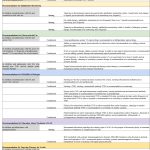Notably, the guideline highlights the importance of early treatment to prevent disability and joint damage, and provides recommendations for escalating care for low disease activity to maintain complete disease control, says Dr. Ringold.
“The recommendation for escalation of therapy in patients with polyarthritis and low disease activity affirms that active arthritis should not simply be tolerated,” explains Dr. Beukelman, who led the ACR’s 2011 JIA guideline development process.
Polyarthritis Recommendations
Initially, the core team wanted to categorize patients into treatment groups based on risk factors for the disease and disease activity, but lacked available data to do so. The recommendations are organized around a set of questions called patient/population, intervention, comparison and outcomes (PICO).
For general medications:
- NSAIDs are conditionally recommended as adjunct therapy.
- Methotrexate is conditionally recommended over leflunomide or sulfasalazine, based on lack of data, difficulty of leflunomide administration in young children and safety concerns for sulfasalazine. Subcutaneous methotrexate is conditionally recommended over oral methotrexate.
- Several recommendations involve the use and administration of glucocorticoids, including the use of intra-articular glucocorticoids as adjunct therapy—with a strong recommendation for triamcinolone hexacetonide use over triamcinolone acetonide; conditional recommendation of oral glucocorticoids as bridging therapy during initiation or escalation of therapy in patients with high or moderate disease activity (course of three months or less to control disease activity during initiation or escalation of therapy); and a strong recommendation against adding chronic low-dose glucocorticoid, regardless of risk factors or disease activity.
- Several recommendations involve biologic DMARDs, with recommendations for combination therapies with drugs including etanercept and tocilizumab over biologic monotherapy, and a strong recommendation for DMARD combination therapy with infliximab.
- A conditional recommendation is for the use of physical therapy and/or occupational therapy in children and adolescents with JIA and polyarthritis with or at risk of functional limitations.
For initial and subsequent treatment:
- For all patients, DMARD therapy is strongly recommended over NSAID monotherapy, and methotrexate monotherapy is conditionally recommended over triple DMARD therapy (for initial treatment).
- DMARDs are conditionally recommended as initial therapy over a biologic for patients without risk factors (including positive anti-cyclic citrullinated peptide antibodies).
- In patients with risk factors, unless a biologic is preferred, a DMARD should precede biologics for initial therapy. Biologics should be considered for patients with risk factors and high-risk joint involvement or high disease activity, or who are at high risk for developing disabling joint damage.
- Conditional recommendations are for the escalation of therapy for children with low disease activity receiving a DMARD and/or biologics, which could include a trial of methotrexate.
- Recommendations for children with moderate to high disease activity, receiving DMARD monotherapy are to add a biologic to the original DMARD over changing to a second DMARD or changing to triple DMARD therapy, or for children receiving their first tumor necrosis factor (TNF) inhibitor to switch to a non-TNF inhibitor. A biologic is conditionally preferable to switching to a second TNF inhibitor. Abatacept or tocilizumab may be preferable to rituximab.
Sacroiliitis Recommendations
To be considered active sacroiliitis, the guideline says, JIA patients must report symptoms of inflammatory back pain or have a positive magnetic resonance imaging (MRI) scan and clinical exam.


